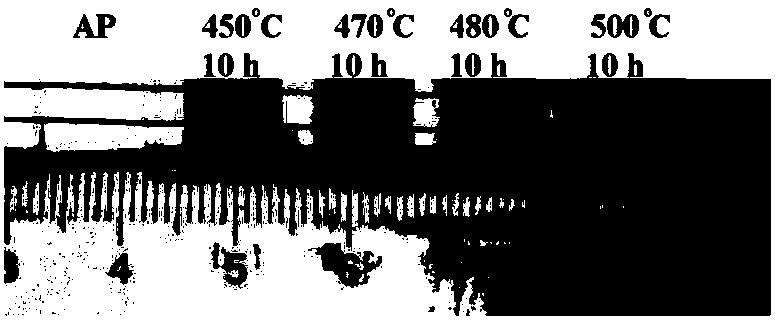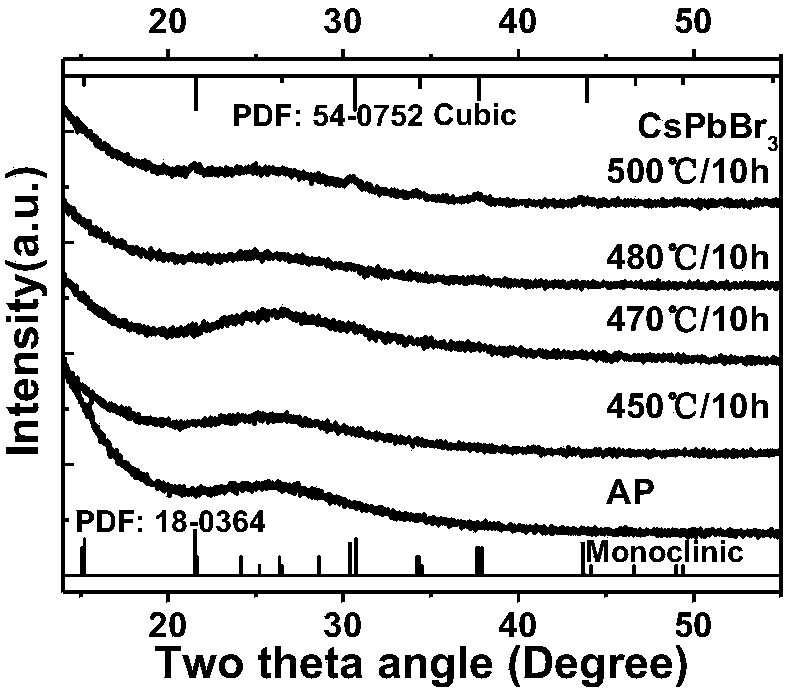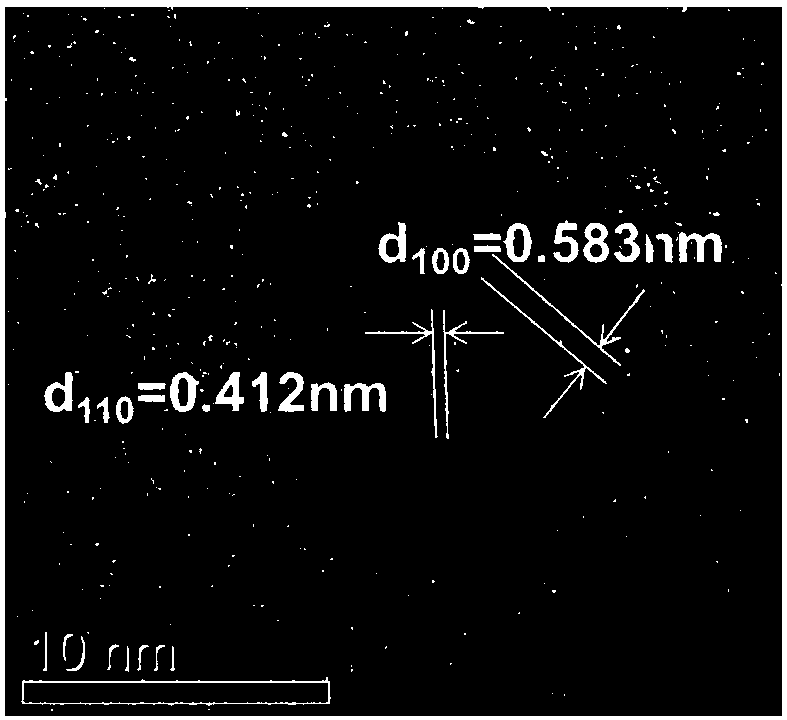CsPbX3 nanocrystalline doped borogermanate glass, and preparation method and application thereof
A germanate glass and nanocrystal technology, which is applied in the field of luminescent materials, can solve the problems of reduced fluorescence efficiency, easy cluster precipitation, poor chemical stability and thermal stability, etc., and achieves improved thermal and chemical stability, quantum High efficiency and controllable size effect
- Summary
- Abstract
- Description
- Claims
- Application Information
AI Technical Summary
Problems solved by technology
Method used
Image
Examples
Embodiment 1
[0080] The raw materials were weighed in the following atomic mole percentages: Ge: 16%, B: 13.2%, Zn: 1.6%, Ca: 0.9%, Pb: 0.9%, Cs: 3.1%, Na: 3.8%, Br: 3.8%, O : 56.7%. After mixing evenly, melt at 1250°C for 30 minutes, then rapidly cool and shape and anneal to obtain completely transparent glass.
[0081] Put the original glass into a heat treatment furnace, heat treatment at 440-500°C for different times, and then cool down to room temperature with the furnace to obtain CsPbBr 3 The nanocrystal-doped transparent glass is polished and tested.
[0082] figure 1 AP and 450°C / 10h, 470°C / 10h, 480°C / 10h, 500°C / 10h heat-treated samples under the fluorescent lamp (AP represents the original glass sample without heat treatment, 450°C / 10h, etc. represent the temperature Heat treatment at 450°C for 10h).
[0083] figure 2 XRD patterns of the original glass and its heat-treated samples under different conditions. Depend on figure 2 It can be seen that in addition to the "stea...
Embodiment 2
[0087] The raw materials were weighed in the following atomic mole percentages: Ge: 15.9%, B: 12.7%, Zn: 1.6%, Ca: 1.6%, Pb: 0.9%, Cs: 3.2%, Na: 3.8%, Br: 3.8%, O : 56.5%. After mixing evenly, melt at 1250°C for 30 minutes, then rapidly cool and shape and anneal to obtain completely transparent glass.
[0088] Put the raw glass into a heat treatment furnace, treat it at 480 ° C for 4 to 10 hours, and cool it to room temperature with the furnace to obtain CsPbBr 3 The nanocrystal-doped transparent glass is polished and tested. Figure 9 is the original glass and its absorption spectrum at different heat treatment temperatures and times, Figure 10 It is the fluorescence spectrogram of the sample in this example under 400nm excitation. Under the heat treatment condition, the fluorescence peak position can be adjusted within the range of 504-532nm.
Embodiment 3
[0090] The raw materials were weighed according to the following atomic mole percentages: Ge: 15.8%, B: 13%, Zn: 1.6%, Pb: 1%, Cs: 3.1%, Na: 5.6%, Br: 3.7%, O: 56.2%. After mixing evenly, melt at 1250°C for 30 minutes, then rapidly cool and shape and anneal to obtain completely transparent glass.
[0091] Put the original glass into a heat treatment furnace, treat it at 470 ° C for 8 hours, and cool it to room temperature with the furnace to obtain CsPbBr 3 The nanocrystal-doped transparent glass is polished and tested. Figure 11 is the original glass and its absorption spectra at different heat treatment temperatures, Figure 12 It is the fluorescence spectrum diagram of the sample in this embodiment under 400nm excitation, and the adjustable range of fluorescence peak wavelength is 515-519nm.
PUM
 Login to View More
Login to View More Abstract
Description
Claims
Application Information
 Login to View More
Login to View More - R&D
- Intellectual Property
- Life Sciences
- Materials
- Tech Scout
- Unparalleled Data Quality
- Higher Quality Content
- 60% Fewer Hallucinations
Browse by: Latest US Patents, China's latest patents, Technical Efficacy Thesaurus, Application Domain, Technology Topic, Popular Technical Reports.
© 2025 PatSnap. All rights reserved.Legal|Privacy policy|Modern Slavery Act Transparency Statement|Sitemap|About US| Contact US: help@patsnap.com



